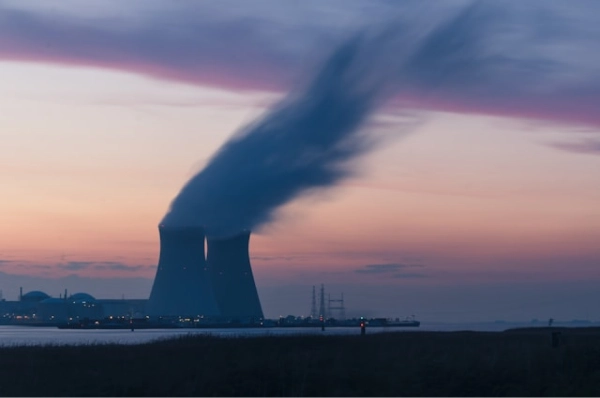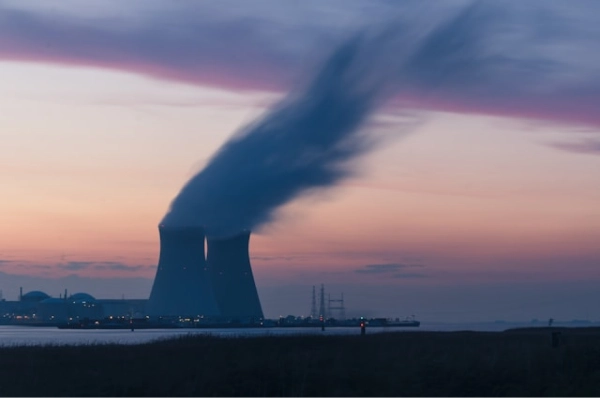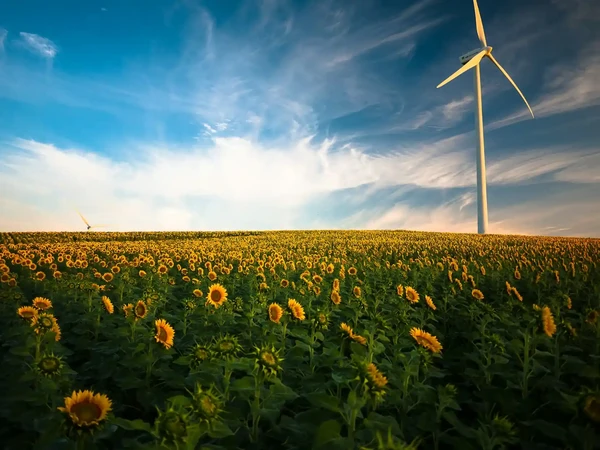Similar to a conventional coal-fired power plant - electricity in a nuclear power plant is generated from heat. The difference in the operation of a nuclear power plant is that this heat is generated not from burning coal but from the fission reaction of the nuclei of uranium 235 (enriched uranium) atoms in the reactor, created by neutrons. The heat is then used to heat water, which, turned into steam, drives the blades of a turbine known as a turbogenerator, or turbine connected to an alternator.

What is a nuclear power plant and how does it work?
On the surface, then, the technology of generating energy from the atom seems relatively simple to describe. However, it is hard to describe it more broadly in a few succinct sentences, for example, in the context of the types of nuclear reactors used. The division depends on the criteria adopted, such as the design itself, the method of fuel exchange, the type of fuel used, and the method of cooling or heat dissipation.
Types of nuclear reactors
Below, we will introduce the key criteria for dividing nuclear reactors and discuss the different types, designs, and fuel changeover. We will also learn about the different types of fuel, moderators, and coolants, as well as the heat removal systems in nuclear reactors.
1. Reactor design
- Tank reactors: core in a thick-walled, high-pressure steel vessel. Types: PWR, BWR, HTGR, AGR, FBR.
- Channel reactors: small diameter pressurized fuel channels. Types: CANDU/ACR, RBMK.
2. Fuel exchange method
- Continuous exchange reactors: fuel exchanged while the reactor is operating (no shutdown). E.g., gas-fired, channel reactors.
- Intermittent exchange reactors: fuel replaced after the fuel campaign is completed and the reactor is shut down. E.g., pool reactors.
3. Fuel type
- Types: Uranium, Plutonium, Uranium-plutonium, Thorium.
- Degrees of enrichment: natural, low, medium, high enriched.
- Chemical form: Uranium metal, Uranium dioxide (UO2), Uranium carbide (UC).
4. Type of moderator and coolant
- Moderators: heavy water, light water, graphite, beryllium.
- Coolants: light/heavy water, carbon dioxide, helium, liquid sodium, organics.
- Reactor types: Aqueous (light water), Heavy water, Gas, Sodium, Helium, Graphite, etc.
5. Heat removal system
- Single-way: e.g. BWR, steam fed directly to the turbine.
- Two-way: e.g. PWR, reactor core cooling water circuit, with steam generator.
- Three-way: e.g., a sodium-cooled reactor, with an indirect sodium circuit.
Popular types of nuclear reactors in the world:
- PWR (Pressurized Water Reactor).
- WWER (Water-Water Energeticheskiy Reactor) - the Soviet equivalent of PWR.
- BWR (Boiled Water Reactor).
- RBMK (Bolshoy Moshchnosti Kanalnyi Reactor) - high-powered channel reactor
- PHWR (Pressurized Heavy Water Reactor).
- CANDU (Canadian Deuterium-Uranium Reactor).
- SGHWR (Steam-Generating Heavy-Water Reactor) - light water-cooled boiling reactor, moderated by heavy water.
- AGR (Advanced Gas-cooled, graphite-moderated Reactor).
- HTGR (High-Temperature Gas-cooled Reactor) - gas-cooled, graphite-moderated reactor.
- FBR (Fast Breeder Reactor).
- LMKBR (Liquid-Metal-cooled Fast Breeder Reactor) - sodium-cooled fast reactor.
- GCFR (Gas-Cooled Fast Reactor) - a gas-cooled fast reactor.
A brief history of nuclear power plants
The history of nuclear power has its origins in the 1950s. However, the biggest and most important "explosion" of this technology for Europe and the World took place since 1973, when Syria and Egypt attacked Israel, which was supported mainly by the United States. As compensation for the enemy's support, Arab countries declared a fuel war on the West, imposing an embargo on oil exports to countries that chose to help Israel. The West, faced a fuel and energy crisis, there was no way out, to survive some alternative way to produce energy had to be found. Just six months after the Middle East conflict erupted, in March 1974, the French government announced a multi-year plan to build nuclear power plants - called the Messmer Plan after the then-prime minister. And although the plan was much more ambitious, 56 nuclear reactors came online in 15 years. This was enough to make France energy independent. At the same time, the U.S. president announced the "Independence" project, under which the U.S. was to become energy independent in 10 years, and by 1980 there were to be, among other things, a bagatelle 1,000 nuclear power plants! The plan failed, among other things, due to the Watergate affair and the lifting of the embargo on oil from the Arab direction, while in the 1970s-80s dozens of nuclear reactors were built in the States.
1950s: The beginnings of nuclear power
- 1954 r.: Establishment of the first 5 MW nuclear power plant in Obninsk (USSR).
- 1956 r.: Construction of the first power reactor in the UK.
- 1957 r.: Commissioning of the prototype PWR reactor in the US (Shippingport).
- 1970s and 1980s: Rapid development of nuclear power, increasing the number of reactors. Launch of the Messmer plan in France.
- 1979 r.: Three Mile Island accident.
- 1986 r.: Chernobyl disaster.
- 1980s and 1990s: Many countries halt construction of new nuclear units.
- 2000 and beyond. Nuclear power resumes consideration due to environmental commitments and rising fossil fuel prices.
- 2011 - Fukushima disaster.
- Today: Continued construction of new reactors in various countries, including Asia, Russia, and Europe.
The origins of the atom in the world
In the 1950s, the era of nuclear power began. The first 5 MW power plants were built in 1954 in Obninsk (USSR), followed by the UK in 1956. These developments contributed to the development of various types of nuclear reactors, which we will discuss later in this article.
Changing the direction of the atom development
In the 1950s and 1960s, the main purpose of building nuclear power plants was not to generate electricity but to produce fissile material for military purposes. However, in the 1970s, with the growing energy demand, the development of nuclear power plants skyrocketed, adding to the interest in the technology. The accidents at Three Mile Island in 1979 and Chernobyl in 1986, as well as the increase in safety requirements for nuclear units, had an impact on the further development of this branch of the power industry.
Stagnation in nuclear development in Europe
In the 1980s and 1990s, many European countries, including Sweden, the Netherlands, Germany and Italy, halted further development of nuclear power, and some even planned to withdraw from further investment in nuclear energy. However, construction of new reactors continued in Asia, including China, India and Korea, and Russia.
Atom as eco-energy?
After 2000, interest in nuclear power increased due to commitments to reduce carbon emissions, rising fossil fuel prices and increasing demand for electricity. The drive for sustainability and minimizing carbon footprints has led many countries to rethink the role of nuclear power in the energy mix. Nuclear power, with low CO2 emissions compared to traditional energy sources, has become an attractive alternative to coal and gas.
Atomic energy development prospects
New nuclear power plant units are planned to be built in various regions of the world between 2024 and 2030 to ensure stability and sustainability in electricity supply. Despite discussions about safety and environmental issues, nuclear power remains an important part of the energy mix, especially in the context of the challenges of climate change.
Nuclear power's share of global markets
In 2022, the world had about 370 GW of nuclear power installed. This produced 2632,03 TWh which accounted for 9,18% of energy production from all sources of 28,660.98 TWh.
For comparison in the same year:
– Coal – 2300 GW - allowed to generate 10,212.22 TWh
– PV –1047 GW - allowed to generate 1310.02 TWh
– Wind power plants – 899 GW - allowed to generate 2098, 46 TWh
Only in EU – in 2023 - nuclear power covered 24,5% of production, generating 588,93 TWh. Of this amount, as much as 318,97 TWh was nuclear power generated in France.

World fleet of nuclear reactors - data
Data as of May 2023: There are currently 436 nuclear reactors located in 32 countries around the world. The United States has the largest number of reactors – 93. Second place on the list goes to France with 56 units and the podium is rounded out by China equipped with 55 reactors.

World's nuclear reactor fleet - age, failures
The data as of July 1, 2023 is not very optimistic. Of the 407 reactors included in the study - the average age is 31,4 years. A detailed breakdown:
- 0-10 years: 71 reactors
- 11-20 years: 30 reactors
- 21-30 years: 41 reactors
- 31-40 years old: 154 reactors - the most numerous group
- 31-50 years old: 98 reactors
- 50+ years: 13 reactors
Between 2018 and 2022, the average "life" age of reactors is 43,5 years. It's hard not to notice that the world's current operating fleet is quite overhauled. New units are needed to replace failing older ones. A good example of how unpredictable and serious reactor failures can be can be found in France, which in 2022 faced considerable technical problems as a result of which it lost almost 50% of its power. The prevailing drought and problems with reactor cooling also had an impact, but the "age" aspect cannot be overlooked. These problems also overlapped in time with planned unit overhauls and, as a result, France went from being an exporter to an importer of energy, which had a significant impact on electricity prices across Europe. It is worth mentioning that the average age of a reactor in France is 38,1 years. Only 5 reactors are in the range of 21-30 years, as many as 32 in the range of 31-40 years and 20 are reactors that have reached 41-50 years.
World nuclear reactors currently under construction and planned
There are currently 55 nuclear reactors under construction around the world, with another 110 planned. Most of these reactors are located in Asia. New plants have come online in recent years, but at the same time many older ones have been decommissioned. Over the past 20 years, 107 reactors have been decommissioned, while 100 new reactors have been put into operation.
In 2024, 10 reactors are planned to come online worldwide, with a total capacity of 11,133 MWe:
- 2 x 1,200 MWe reactors (Rooppur 1 and 2) in Bangladesh,
- 3 x reactors of 600, 1212, 1500 MWe (Xiapu 1, Zhangzhou 1 and Shidaowan 1) in China,
- 1 x 1650 MWe reactor (Flamanville 3) in France,
- 1 x 500 MWe reactor (Kalpakkam PFBR) in India,
- 2 x 1400 MWe reactors (Saeul 3 and 4) in South Korea,
- 1 x 471 MWe reactor (Mochovce 4) in Slovakia,
Kolejne lata to:
Year 2025:
- 8 reactors with a total capacity of 9,622 MWe in China (3), India (2), Russia (2) and Turkey (1),
Year 2026:
- 10 reactors with a total capacity of 8,377 MWe in China (6), India (2), Russia (1) and Turkey (1),
Year 2027:
- 11 reactors with a total capacity of 11,729 MWe in Argentina (1 very small reactor of 29 MWe), China (7), India (2) and Turkey (1),
Year 2028:
- 8 reactors with a total capacity of 9,607 MWe in Iran (1), China (5), Egypt (1) and Turkey (1),
Year 2029:
- 3 reactors with a total capacity of 4,132 MWe in China (2) and the UK (1),
Rok 2030:
- 5 reactors with a total capacity of 6,520 MWe in Egypt (3) and the UK (1)
Total from 2024 to 2030 there are 55 reactors under construction with a total capacity of 61,120 MWe.
The largest number of nuclear reactors will be commissioned in:
1. China - 26 with a total capacity of 29,763 MWe
2. India - 7 with a total capacity of 5,900 MWe
3. Egypt - 4 with a total capacity of 4,800 MWe
4. Turkey - 4 with a total capacity of 4,800 MWe
5. Russia - 4 with a total capacity of 4,010 MWe
6. United Kingdom - 2 with a total capacity of 3,440 MWe
7. South Korea - 2 with a total capacity of 2,800 MWe
8. Bangladesh - 2 with a total capacity of 2,400 MWe
9. France - 1 with a capacity of 1,650 MWe
10. Iran - 1 with a capacity of 1,057 MWe
11. Slovakia - 1 with a capacity of 471 MWe
12. Argentina - 1 with a capacity of 29 MWe

The above data indicate where nuclear power development will be most dynamic in the coming years. The clear leader here is China, which stands firmly apart from the rest of the stakes. Europe is at the gray end of this list unless we partially attribute to Europe the capacities being built in Russia or Turkey... Either way, there is no illusion that China is the clear leader in terms of capacity and the number of nuclear power plants that will be put into operation in 2024-2030.
What's next? - Nuclear power after 2030
There is already another 90 GWe of capacity planned* for the world, which will accrue to 92 reactors and another 343 have been proposed** with a total capacity of 364,050 MWe.
*planned - approved financing or commitments, operation to begin within the next 15 years.
** proposed - a program or location has already been specified, the start date is highly uncertain.
Again, it is worth mentioning here that among the reactors planned, 41 are reactors in China with a total capacity of 44,660 MWe, while in the category of reactors proposed it is as many as 158 units with a total capacity of 186,450 MWe! Russia, next in the rate, is planning 14 reactors with a total capacity of 8930 MWe and has "proposed" 36 units with a capacity of 37,716 MWe, India, in turn, 12 reactors with a total capacity of 8400 MWe (planned) and 28 reactors with a total capacity of 32,000 MWe (proposed).
These numbers are impressive.
Are these ambitious plans possible? Delays in global projects and a nuclear power plant in 4 years....
The planned development of nuclear power in the world is unquestionably impressive while one must be aware of the various obstacles that may arise. One of the most common threads associated with nuclear power is the subject of project delays. The assumed lead time very often diverges sharply from the real time in which these power plants manage to come online. Between 2020 and 2022, the average delay time for nuclear power plants under construction worldwide was 7,9 years. Virtually every unit was commissioned later than planned in the original assumptions.

A record delay in the construction of a nuclear power plant was recorded by the Finns, who commissioned the Olkiluoto-3 unit 16.6 years later than planned. What's more, such long delays caused the cost to skyrocket from the originally planned 3 billion to about 11 billion EUR, or more than 3,5 times as much.
Other examples of projects with long delays that have not yet been launched:
- Flamanville 3 – Normandy, France - construction started in 2007, planned completion year 2012, planned cost €3,3 billion. It is currently estimated that the reactor will be commissioned in 2024 and its cost will be 4 times as much - about €13,2 billion.
- Hinkley Point C – UK – construction started in 2018, the planned year of completion is 2025, planned cost - £18 billion, in the currently "worst-case" accepted scenario the launch could occur as early as 2031 and the final cost could be as high as £35 billion.
We already know about delays and underestimated costs. So what is the average construction time for a nuclear power plant?

A nuclear power plant in 4 years? Yes - the shortest construction time for a nuclear power plant in China between 2013 and 2022 was 4.1 years. The longest reactor under construction during this period was Watts Bar Unit 2 - in Tennesy, USA, the construction time was as long as 42,8 years. Construction began in 1973, then stopped in 1985 until 2007 when work began again. The unit was finally put into operation in 2016.
The average construction time for a nuclear power plant between 2013 and 2022 in the world is 9,4 years.
Polish nuclear power plant - Large reactors
The topic of nuclear power in Poland has been seriously discussed since 2005. Interestingly, almost 20 years have passed and still not a single nuclear power plant or reactor has been built in Poland.
Here are some key dates for Poland's nuclear power industry:
- 2005: The Polish government decides to introduce nuclear power into the energy system.
- 2009: A report for the Ministry of Economy identifies nuclear power as the most effective way to reduce CO2 emissions.
- 2011: January: Government approves new energy program.
- 2011: May: Parliament passes nuclear power legislation.
- 2018: The Energy Ministry is publishing a draft of Poland's Energy Policy until 2040.
- 2021: February: The government adopts Poland's Energy Policy until 2040.
- 2021: April: Establishment of the company „Polskie Elektrownie Jądrowe (PEJ); Polish Nuclear Power Plants”.
- 2021: December: Signing of an agreement between PEJ and Westinghouse to determine the next steps in the construction of a nuclear power plant.
- 2023: September: PEJ signs an agreement with Westinghouse and Bechtel to complete the technical design and begin work on the construction of the first three 3 x 1,250 MWe units at Lubiatowo-Kopalino. The planned start date for construction is 2026, and the commissioning of the first unit is 2033.
The technology has been chosen, and so has the location. The first work to prepare the site for the construction of a nuclear power plant has just begun (in March 2024) - about 40 hectares of forest have already been cleared and by February 2025 another 150 hectares in the Choczewo municipality will be gone. As late as May 2024, geological work is to begin. But does this mean that a nuclear power plant in Poland will be built in time? Looking at the history of projects around the world, delays, problems, cost increases, and above all the history of the nuclear power plant in Poland (19 unproductive years), one can have considerable doubts. The most recently built and commissioned reactors using US AP1000 technology are Vogtle 3 and Vogtle 4 in the state of Georgia, USA.
Voglte 3 – Construction started in March 2013, planned completion - 2016, start of commercial operations - July 31, 2023, delay: 7 years.
Vogtle 4 – Construction started in November 2013, planned completion July 2017, start of commercial operations, currently on schedule to start commercial operations - 2nd half 2024. Delay: 7 years.
The planned construction cost of the two reactors - $13 billion, the actual cost is expected to be about $34 billion.
Polish nuclear power plant - Small reactors
Many industrial companies in Poland with large energy needs, such as Synthos, Ciech, KGHM and Orlen, are planning to upgrade their plants to include small nuclear reactors. Some highlights of recent developments in this area:
- August 2021: Synthos signed agreements with GE Hitachi Nuclear Energy and Ultra Safe Nuclear Corporation to develop small modular reactors (SMRs).
- September 2021: NuScale began working with KGHM Polska Miedź to explore the possibility of replacing coal-fired power plants with nuclear reactors.
- January 2023: Respect Energy signed an agreement with EDF to develop projects based on Nuward SMR technology.
- February 2023: Orlen CEO Daniel Obajtek announced plans to build 76 SMRs at 26 sites by 2038, with the first reactor in 2028.
- April 2023: Orlen Synthos Green Energy announced seven potential sites for GE Hitachi BWRX-300 units.
- May 2023: The State Atomic Energy Agency issued a positive opinion on the BWRX-300 project's compliance with Polish nuclear safety standards.
- December 2023: The Polish government authorized the construction of up to 24 BWRX-300 reactors at various locations.
Nuclear power plant - summary
In the global energy mix, nuclear has not yet said its last word. Plans for the development of nuclear power in the world are very ambitious. They are led by China, which confirms its ambitions (unlike, for example, the European Union) with concrete deeds. The implementation of nuclear projects involves great risks and enormous expenses. There are long delays and costs are several times higher than originally planned. However, looking at the current trend - reducing emissions and the ratio of installed capacity to energy produced - highly efficient nuclear power simply has to develop if the world wants to abandon fossil fuels for power generation, and especially coal power generation.
Atom, unlike renewable energy, is a much more stable and efficient source. While it is not completely independent of the weather (depending on the technology used, nuclear power plants can be susceptible, for example, to the reactor cooling problem that occurs in the event of a drought), it is highly efficient and zero-emission. Of course, there is also the issue of the disposal and circulation of waste generated in the production of electricity from uranium, but this is a topic for a separate article. Will nuclear power plants develop according to the world plan? Will they replace conventional power plants or perhaps become the world's primary source of energy?
We will eagerly watch the developments in Poland and the world, although you certainly have to be patient here. As the classic used to say, "It's not a bakery."
Sources:
https://www.worldnuclearreport.org/
https://whatisnuclear.com/history.html
https://www.statista.com/statistics/267158/number-of-nuclear-reactors-in-operation-by-country/
https://world-nuclear.org/information-library/current-and-future-generation/plans-for-new-reactors-worldwide.aspx
https://www.eia.gov/todayinenergy/detail.php?id=57280
https://www.grs.de/en/news/situation-nuclear-power-plants-france-how-has-situation-evolved-our-neighbouring-country
https://swiadomieoatomie.pl/Energetyka-jadrowa/Kompendium-wiedzy/Elektrownia-jadrowa/Jak-dziala-elektrownia-jadrowa
https://zpe.gov.pl/a/dzialanie-elektrowni-jadrowej/D2WueFLpG
https://world-nuclear.org/information-library/current-and-future-generation/nuclear-power-in-the-world-today.aspx
https://pl.wikipedia.org/wiki/Elektrownia_j%C4%85drowa
https://ember-climate.org/data/data-tools/data-explorer/
https://www.cire.pl/strony/rodzaje-elektrowni
https://smoglab.pl/ceny-energii-w-dwa-miesiace-skoczyly-o-300-proc-co-rzady-zrobily-w-1973-roku/
https://pulaski.pl/pulaski-policy-paper-m-oettingen-koszty-i-terminy-budowy-elektrowni-jadrowych-realizowanych-przez-potencjalnych-dostawcow-technologii-jadrowej-dla-polski/
https://energetyka-jadrowa.cire.pl/artykuly/serwis-informacyjny-cire-24/blok-4-w-elektrowni-jadrowej-vogtle-w-amerykanskim-stanie-georgia-zostal-po-raz-pierwszy-zsynchronizowany-i-podlaczony-do-sieci-elektroenergetycznej



